|
Collecting Apothecary Jars and Wares
by Daniel A. Goldstein
Posted March 2016

|
My obsession began with four apothecary bottles on my mother’s bookshelf. What was kept in these mysterious Latin-labeled containers? What was the medication used for? How did it come to be? Other forces conspired—my mother made me take Latin in high school, having no idea I was headed for chemistry, biology, and medicine. My medical school interest in therapeutics drove me to learn more, work with a pharmacologist, and pursue a fellowship in pharmacology, which grew to include toxicology as well. Looking back, I suspect my interest in those four bottles drove both my hobby and my career.
My earliest collecting involved patent medicine bottles, available in infinite variety for a few dollars or tens of dollars. A favorite find, Turlington’s Balsam, the first known patent medicine in North America, cost three dollars at an antique mall in Augusta, Ga. The genre also includes tins, advertisements, trade cards, promotional items and other paraphernalia. “Patent” medicines were readily copied and thus had little ingredient labeling, were rarely patented, and had closely guarded formulas. Consequently, this genre provides more insight into the development of glassblowing and advertising than therapeutics. Bottle characteristics assist in dating and authentication, a complex topic. To assist, the Society for Historical Archeology (SHA) provides extensive free resources online (https://sha.org/bottle).
|
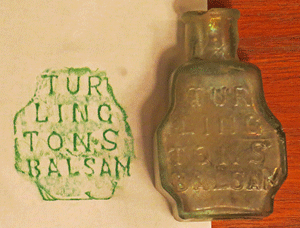
|
Turlington’s Balsam, first patent medicine known to be imported to the American Colonies. Glass, embossed, 2.5-inches in height, with rubbing beside it. It was produced in England from 1744 until ca. 1900 in similar pear-shaped bottles, making precise dating difficult. Probable dates, 1850-1890.
|
Glass and ceramic apothecary containers are far more elegant. Glass containers below 12 inches in height are typically in the $20-$50 range. Ceramic containers tend to be more costly, $50-$200 for 19th or 20th century objects, but older containers often rise far above $1,000, including some from before the Christian era.
To protect labels from drips, spills, and hard usage, druggists turned first to glazed ceramics and later to labels under glass, assuring that the label survived and allowing much to be said about the origin and use of the contents. Glass labels, patented in 1862, were first applied to unmodified bottles but evolved to recessed labels on specifically designed bottles. Early versions employed paper or foil labels with glass slipcovers; later versions were painted or printed directly onto glass and fused to the container.
|
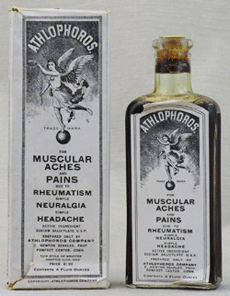
|
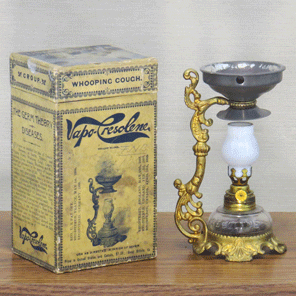
|
|
Athlophoros, a typical patent medicine for pain relief, 20th century, American. Glass bottle with paper label, cork closure, and contents; box is 7 inches high. The label reads: “Athlophoros Co. and Newton Searles, proprietor, Pomfret Center, Connecticut.” While sold from the 1880s, the box indicates: “This style label adopted June 1939.”
|
Vapo-Cresoline Lamp, American, ca. 1900, metal and glass, 8 inches high. This oil or kerosene lamp made by the Vapo-Cresoline Company (formed 1879 in New York City) was used to vaporize the Vapo-Cresoline product which contained a disinfectant (carbolic acid) for treatment of respiratory disorders. The product and various vaporizers, including later electric models, were available into the 1950s.
|
Closely related to bottles are drawer handles and cabinet pulls of ceramic, glass (with fused glass labels), metal or wood. These include labels for sundries or broad categories of products (suppositories) or materials (plants), sometimes with alphabetical references; e.g., “Foliae A~G” refers to leafy material, A through G. Whether container or pull, all commercial labels should be clean and sharp, which brings us to issues of reuse, repair and authenticity.
Modern copies of containers exist, particularly of ceramics, including those from medieval times. My expertise in ceramics is limited; but note that many copies were made without ill intent. Drug companies used replica ceramic containers as advertisements, particularly Darvon, and several series of containers with historical inscriptions have been distributed as promotions. On authentic sets, wear is expected and should be uneven, with commonly used containers showing greater wear.
Attempts to replicate recessed-label glass containers are rare, as doing so would be expensive and difficult. One often finds containers which have been re-labeled, often with the glass cover missing, as well as glass labels on containers that are probably not their original destination. Poor quality labels are usually not original, but in both circumstances, it is difficult to distinguish legitimate historical relabeling to meet a druggist’s need from recent attempts to enhance value using parts from damaged items.
|
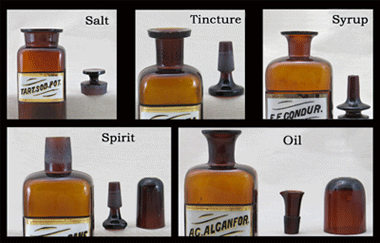
|
Bottle closure types: salt-mouth (wide-mouth) bottles held solids; tincture bottles held water or alcohol-based solutions; syrup bottles lacked a tight seal which might become frozen in place by sugar, spirit bottles held volatile materials and had a double seal, while oil bottles had a removable pouring spout to reduce drips. All bottles from Whitall Tatum & Co., ca. 1900, 10 inches high.
|
Useful clues to authenticity can sometimes be gathered from the terminology itself. Spelling variants are so common as to be useless, but when a series of containers carries exclusively modern terminology (arsenic, opium, cocaine for example) as opposed to traditional Latin, one should be suspect. Conversely, Victorian era and later items were sometimes given pseudo-Latin names; e.g., Lysol disinfectant marked “Lysolum.” Such containers are confusing but often legitimate, especially if found as part of a set. By far, the most useful clue regarding authenticity is the relationship between labeled contents and bottle type. The physical state of a material is often evident from the label or can be obtained by searching on a mobile device. You also need a bit of knowledge about bottle closures. There is logic to the styles used: solids require a wide mouth; water-based liquids, a small mouth and tight seal; syrups, a sharp lip but no tight seal to become stuck by dried material; volatiles (like ether), a double-seal to limit evaporation; and oils, a pouring spout to reduce drips without need for a tight seal. If one finds a label for a powdered material on a small mouth bottle or other such mismatch, it strongly suggests the container was recently created or altered by someone unfamiliar with apothecary practices.
|
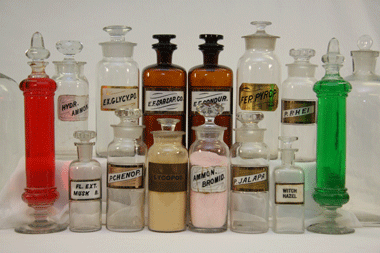
|
Assorted bottles from the author’s collection along with two cylindrical show globes.
|
Authentic containers and pulls commonly carry labels for non-drug items. Chemicals and sundries include photographic supplies, pesticides, mothballs and potpourri, fragrances and cosmetics, household cleaning products, flypapers, paints, dyes, and supplies for both medical (bandages, forceps, droppers, eye cups, atomizers, nursing and infant supplies, hot water bottles, enema bags) and personal (combs, brushes) care. Tobacco, tea and coffee containers were infrequently carried by apothecaries, resemble apothecary jars and often came from the same manufacturers. They are usually quite large to allow entry of a hand or scoop, and they often display product-related motifs such as Indians for tobacco. These were frequently reproduced and are frequently intermixed with apothecary jars by less knowledgeable dealers. Fortunately, they are distinct enough to recognize as not being apothecary wares. They usually say little about the authenticity of other assorted containers on the shelf.
Apothecary wares include show globes, which are elaborate containers filled with colored liquids or powders that serve as symbols of the apothecary trade. These command substantial prices—several hundred to many thousands of dollars for very large or elaborate containers. Copies abound, often in brightly colored glass. Authentic specimens should have ground-glass closures, and they were generally uncolored before 1920. Beware of beverage dispensers with spigots, as apothecary symbols may be added to enhance their value. Few, if any, are true show globes, although vintage specimens may have been used at the soda fountain.
|
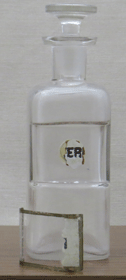
|
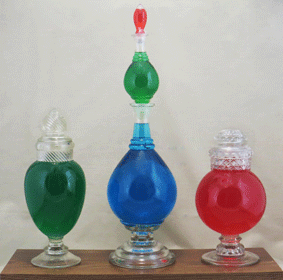
|
|
An apothecary bottle showing a recess and separate glass slip-cover with remnants of original label. The glass bottle is 8 inches high with a ground glass closure; bottom embossed with, “Patent Appr. 1888 | W.T.Co. | C”, indicating a copyrighted bottle from Whitall, Tatum and Company, American, 1888-1920.
|
Show globes, glass with colored water, 12-20 inches high, and no maker’s marks. The two globes on the right are identifiable in Whitall-Tatum & Co. catalogs ca. 1880 and are authentic. The globe on the left lacks a proper ground-glass closure, and while not new based on surface aging, it is likely a post-1940 copy.
|
A morbid but colorful genre is the poison bottle, a dispensing bottle for highly toxic medications, required in the U.S. and parts of Europe from 1870 to 1930. Odd shapes, heavily textured surfaces and distinctive closures served to warn of danger when a bottle was grabbed from the medicine chest at night. While its use faded in part due to a decline in highly toxic medications like calomel, the need for the genre was ultimately eliminated by bright, convenient electric light.
Poison bottles are popular enough that fakes, usually brightly colored, are common. These bottles span the introduction of automated production (1903), so carefully consider bottles with machine markings (seams running nearly to the lip of bottle or a suction ring on the bottom; see the website noted above), but many are perfectly legitimate specimens.
|
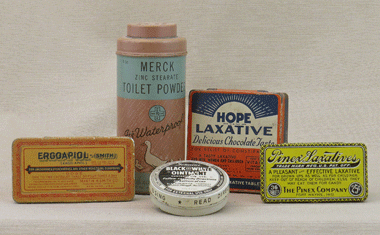
|
Medication tins, likely 1920-1960 vintage, American. (L-r) Ergo-Apiol (for menstrual disorders); Merck Zinc Stearate Toilet Powder (“It’s Waterproof!”); Hope Laxative (“When nature halts, there’s Hope!”); Pinex Laxative; and (front) Black and White Ointment (still available in a similar container, but containers from this manufacturer, Plough, are 1920s-30s).
|
Other attractive and fun items include: custom branded dispensing bottles embossed with a specific pharmacy or drugstore chain (collect your town, state, etc..); scales and weights; prescriptions and ledgers; sundries; catalogs; manufacturing equipment for pills, suppositories, and troches; label dispensers; and even cabinetry, which can create a beautiful library or study. The apothecary universe would seem to have something for virtually every collector—no matter what constraints of time, space or bank balance apply.
-------------------------------------------
|
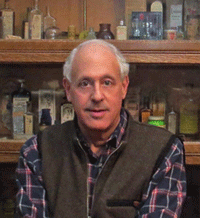
|
Daniel Goldstein is a pediatrician, pharmacologist, and toxicologist with a longstanding interest in apothecary wares, and he has an extensive private collection. He is the author of The Historical Apothecary Compendium—A Guide to Terms and Symbols, which is a comprehensive, illustrated handbook for collectors of American or British goods from colonial times through 1920. With more than ten thousand entries for apothecary terms, it also informs on the history of containers and labels, apothecary processes, weights and measures, therapeutic actions, disease states, Latin, alchemical symbols, bottle manufacturers and botanical terms.
|
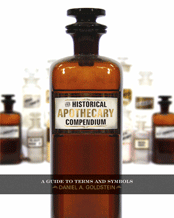
|
|